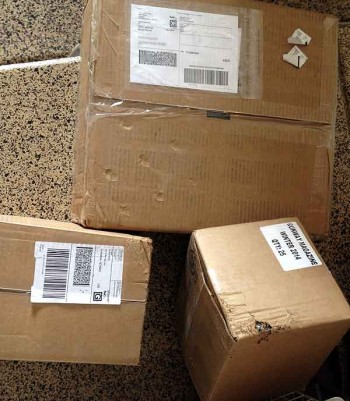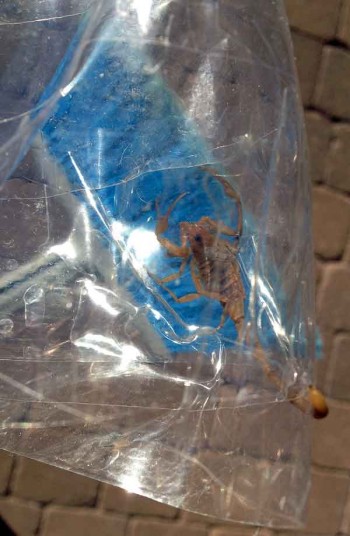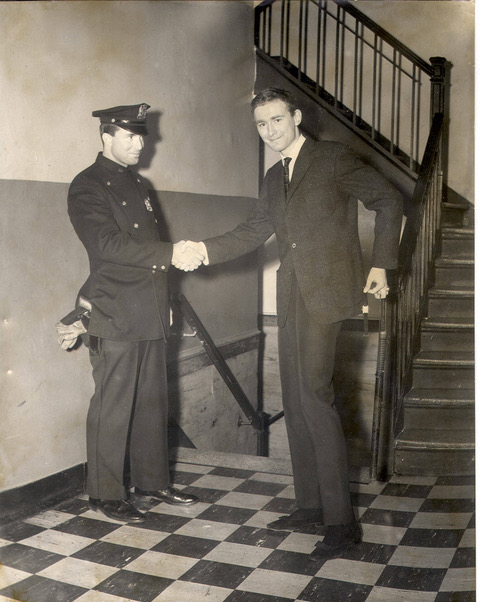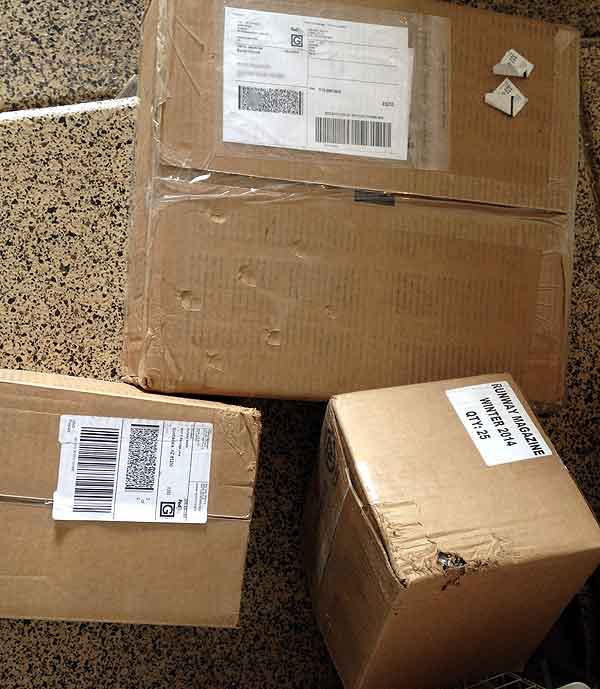The destructive javelina vandals returned—but we were ready for them!
Continue readingTheft by wild animals
Javelina vandals caught on camera.
Continue readingMy Choice to Become an American
I still feel my choice to become an American many years ago was the correct one.
Continue readingFedEx delivery failure – boxes fall off truck

So, I’m expecting a couple of packages. The FedEx tracking site says they’re “on vehicle for delivery.” Yippee!
When your box falls off a FedEx truck
That morning, my niece is driving around some five miles from my house. She swerves around a small heap of boxes in the middle of a residential road and, without time to stop and look at them, she phones a family employee. “They should be moved before someone drives over them,” she says. The family employee drives over to attend to the boxes.
And lo! She notices that they are addressed to me! Amazing coincidence, everyone agrees. But wait—there’s more!
She sends her assistant to deliver the boxes to me. Two are mine, undamaged. The other two are to “Vincent,” but not to me. Some other Vincent, at Runway Media, on the far side of a neighboring city. I didn’t notice the addressee though, and opened one of the boxes. It contained fashion magazines. My own boxes contained books; these other boxes had the appropriate size and heft.
I got my boxes, despite the FedEx delivery failure. But what would the driver think when he couldn’t find the boxes logged in for the day’s deliveries? Are boxes logged in?
And more interesting: how can a number of boxes tumble off a truck? Doesn’t the driver shut and lock the cargo door when not loading or unloading? Federal Express is often considered the most expensive of the courier companies. Doesn’t that also mean the best?
I decided not to alert Federal Express right away. I wanted to see how they’d handle the disappearance of boxes logged for delivery. And I figured (hoped) that the fashion magazines were not urgent. (I was right.)
Days pass, and FedEx does not phone me. The FedEx tracking page continues to advise “on vehicle for delivery.”
Meanwhile, I tell the story of the FedEx delivery failure and coincidental acquisition of my boxes to several people. One was my sister, whom I told over a leisurely dinner. I happened to include the detail about the other Vincent’s boxes, which were still sitting in my garage.
“Wait. Runway Media? I know who those magazines go to!” my sister said. “My fashion designer friend just did a photo-shoot for Runway Media and is getting copies of the magazine.” She’d be seeing him in a few days and would bring him the boxes.
My sister’s fashion designer friend is not Vincent, and is not Runway Media, but the magazines are for him. We actually skipped a link by delivering the boxes directly to him but, hey—we’re more efficient than FedEx.

FedEx delivery failure
After a full week, and with the FedEx tracking page still advising “on vehicle for delivery,” I finally phone FedEx. “Alex,” a local supervisor, is not impressed and barely interested. He asks minimal questions. He promises, in a vague manner, to follow up with the driver. I’m left feeling that boxes falling off a FedEx truck is an everyday occurrence, a regular part of FedEx business.
I feel like documenting this FedEx delivery failure, not because the accident occurred, but because of the lax, slipshod, negligent manner in which FedEx handled the incident. Well, the company didn’t handle it. For the entire week I waited, it pretended nothing irregular happened.
Also, the series of coincidences is pretty amazing and a little funny.
FedEx is clueless. I’m left unsatisfied. I would have accepted an apology. The shipper might have accepted a refund. Oh, but the shipper was never notified either. Never told there were irregularities, that their packages vanished. FedEx hoped no one would notice. Yeah, clueless.
Even today, 12 days after my boxes fell off the FedEx truck, that embarrassing tracking page claims “on vehicle for delivery.” Has FedEx no shame? no pride?
How to kill scorpions
 You may want to know how to kill scorpions if you find them in your house, as I do. Or maybe not. I am not bugphobic, though I do prefer that multilegged creatures remain in their own territory—outdoors—and stay out of my house. But these things—well, my skin gets clammy just thinking about these prehistoric-looking monsters.
You may want to know how to kill scorpions if you find them in your house, as I do. Or maybe not. I am not bugphobic, though I do prefer that multilegged creatures remain in their own territory—outdoors—and stay out of my house. But these things—well, my skin gets clammy just thinking about these prehistoric-looking monsters.
Alas, I come across a scorpion intruder once or twice each month. I cannot allow them to stay. Neither can I capture and release, as I do with spiders. They must die. Sincere apologies if you’re a scorpion-as-pet aficionado. (But why?)
Though you can’t tell in the picture, the creature above blends into my stone floor. Here it is, injured, with an oozing wound on its back after a traditional slap with a slipper before I knew better. I went away a little shaken, this being my first encounter with a scorpion. When I returned, it was gone! It turned up three days later in my bedroom, expired.
How to kill scorpions

You can’t always just smash a rogue scorpion with a shoe. They get into corners and cracks and hard to reach places. With their hard exoskeletons, they’re impossible to smash on carpet. And who wants scorpion guts all over the place? My sister devised this foolproof method to kill scorpions. Necessity is the mother of invention, right?
Wrap tape around a broom, sticky side out. Make sure it’s secure. Now whack your intruder—the scorpion—and watch it stick, immobilized. It may wave its ugly tail a bit, or try to signal a truce with a pedipalp; but it’s not going anywhere. Fear not tight corners, door jambs, awkward spaces. The flexible broom bristles perform well in all instances. Bonus: distance between you and the arachnid.

At this point, all you need is another length of tape. Sandwich the critter, slide the tape off the broom, and get rid of the evidence.
The weakness in this method is that you have to leave the scorpion to go make the scorpion-killer-broom. However, you never want to take your eyes off a scorpion in the house. If you come back and it’s gone, you might not sleep for a week. My sister’s solution: She kept two scorpion-killer brooms ready to go, in opposite ends of her house.
Eventually, my sister had her house scorpion-proofed. Expensive, but it worked. All vents, outlets, light-switches, and other openings were screened on the inside (behind the wall). Pocket doors were sealed—made permanently open or closed. I don’t know what other physical barriers were installed, but she never saw another scorpion.
For now, I’m sticking with the scorpion-killer broom. Good luck!
Salvador Dali theft prevention
Hotel Oddity #28
A devious scorpion scam

Intruder on the loose. In the midst of all the excitement of the premiere of our National Geographic documentary, and all the television promotion that came from it, we’ve moved. From Las Vegas to the Phoenix area, from one desert to another, as if Vegas wasn’t hot enough for us.
The soundtrack at our Vegas house was primarily sirens, especially at night. These were often accompanied by the Doppler effect of percussive, droning police helicopters as they circled my neighborhood, even, seemingly, my house, with blinding searchlights flashing through my windows as if I might be harboring the criminal on the loose.
“Another criminal on the loose,” I’d always say. Between the sirens and helicopters, there was the pleasant, haunting whistle and distant rush of freight trains. That sound I liked.
In my new house, the audio is dominated by silence. I hear coyotes every night. They howl nearby and rush yipping in pack formation through my backyard. One bunny fewer hops through the yard at breakfast. I hear owls, too. And yes, I’ve seen the coyotes. Three of them together, waltzing across my backyard early in the morning.
Last week, walking toward my bedroom, I heard a crunch. Turning, I was horrified to see that I’d stepped on a giant scorpion. It must have fallen out of the rolled rug I was carrying. Yikes!
The scorpion was running in circles when I turned to see it. I should mention that, luckily, I was wearing moccasins at the time. I could have been barefoot. Even with soft shoes on, my left foot felt guilty and creeped out for hours afterward. As if I could feel the contact point.
I fled the scene to phone my nearby sister, who’s well-acquainted with these primeval exoskeletoned creatures, and who had her house “scorpion-proofed” after confronting too many of them.
“You left it unattended?!” she accused. “They’re very hard to kill. You probably only broke a leg or two. Cover it with a jar and a weight.”
I went back to examine the monster, remembering the live edible specimens I’d seen in Beijing earlier this year. It was a few feet away from where I’d last seen it, but still. Not moving. It seemed to be dead. I bravely stamped my foot loudly beside it. It didn’t move. I blew on it. Nothing. I snapped the photo above and left the house to get Bob at the airport.
“Watch out for the dead scorpion in the hall,” I told him, as he headed for the bedroom.
“Where?”
Gone! That was the moment I began to wish for the police helicopter searchlights. A giant scorpion on the loose. In my house. With reason to be vengeful. I wondered if I’d be able to sleep.
Obsessing on the fact my sister had mentioned: that they carry their babies on their backs. A whole brood could already be scampering into my shoes and sheets and up the curtains.
Two days later Bob found it. Dead, in the bedroom. Which is some distance from the site of the accident. Or was it the same scorpion…? Dead, it didn’t look so giant.
The next day I started when I saw a scorpion on the kitchen table. Bob had brought the mail in and a postcard peeked out from the bottom of the heap. It had a realistic photo of a scorpion on it, and advertised a scorpion extermination service. Hmmm… what a coincidence. Would a scorpion exterminator plant a few of the devils to scare new residents into its service? I tell you, it’s on the verge of working.
I cannot bang every shoe before I step into it. I cannot shake out the bed sheets every night, or scan the walls and ceilings for creepers. I can’t live like that. For now, I’ve decided to put them out of my mind and ignore them. At least until the spring, when they become more active. At least until I see another one.
And I’m saving that postcard.
Pickpocket passion

Hamburg, Germany—Undercover pickpocket cop Michael-G is the first person we’ve met who exceeds our own nutcase-level of fascination with pickpocketry.
The day we spent together a year ago was all nuts-and-bolts info-sharing, technique-talking, statistic-rattling, drollness-swapping, photo-showing, video-viewing…. You know, the usual for pickpocket enthusiasts.
Over the years we’ve come to know a few others with extreme interest or knowledge in street thievery. The first may have been Terry Jones in Barcelona, whom we met exactly ten years ago. His observations of the pickpockets and bag snatchers in his own neighborhood led him to compile a loooong page of local street-theft incidents. On the surfeit of simple, opportunistic pickpockets, he’d already come to the conclusion that “there is little in the way of evolutionary pressure to make them improve their methods. The tourists are too many and too unaware, the police are too few, and the laws are too slack.”

The mysterious Monsieur F in Paris is a passionate pickpocket cop who works as “an invisible man;” his identity cannot even be hinted at. As one might expect of a Frenchman, the guarded Monsieur F shares his emotions freely. He tells us that, although his priority is arresting thieves and keeping the public safe, he “sometimes finds victims unfriendly and pickpockets compelling.” For example, when he “arrests a thief with AIDS who has just stolen a purse with ten euros, it is difficult judge the morality…”
We had the great pleasure of introducing Michael-G to Monsieur F, and then heard from both of their delight in their new friendship and information-exchange.
Last week we spent a relaxing day at Michael-G’s tidy, upscale home in a sleepy Hamburg suburb where, over cappuccinos (he’s a first-rate barrista, too), Michael-G’s obsession with all things pickpocket could not be concealed.
His library is extensive, possibly comprising every book and film on pickpockets in existence (including my own book). A life-sized mannequin stands nearby, fully-suited, seven bells sewn to its pockets. Michael-G uses the mannequin in his lectures, but I suspect there’s a little more to the relationship.

He’s taught himself to do a little stealing—for show, of course—so he can entertain and demonstrate at his police presentations. And he runs a website, http://www.taschendiebstahl.com.
Michael-G admits that he lives, breathes, and dreams pickpockets. Bob and I were most impressed by his pickpocket postcard collection. I didn’t even realize such things existed. They’re beautiful, mostly old, and from the world over.
Are there any pickpocket-obsessed painters or cartoonists out there?
10,000 shipping containers lost at sea each year

> Even more! See edit at the bottom.
10,000 shipping containers are lost at sea each year! From my naive perspective, I’m shocked by this number. Twice, I’ve sent an entire household from one continent to another by sea. To think of my container just…tumbling into the sea in a storm! Or worse, ordered jettisoned by the captain to ensure the safety of the ship.
Five to six million shipping containers are being transported at any given moment, and it’s estimated that one is lost about every hour. A goner. True, the percentage is low; but the number is high. Ten thousand containers and their cargo, every year, sunk to the bottom of the deep blue sea. Or presumably, the rough gray sea.
Containers dropped from cargo ships are never recovered and rarely reported. There are no legal repercussions for the losses; no accountability.
There are other repercussions though. Hazardous materials are leached into the ocean. Artificial habitats are created for aquatic life, strung like stepping stones along shipping routes, possibly giving species an unnatural ability to migrate across oceans.
And these cargo containers may float for days or weeks before they sink to the ocean floor. Huge farting boxes the size of houses, invisible just below the surface of the sea, they create a deadly hazard for other ships and yachts. “Very, very dangerous,” a ship’s officer told me. “At night you cannot see them at all.”
While this subject matter doesn’t quite fit my usual categories of Travel or Theft, it interests me mainly in terms of loss and responsibility (and also freak accidents). And there seems to be a huge potential for fraud.
Apparently, expediency in loading cargo ships doesn’t allow for stacking containers logically. Therefore, heavy containers may very well ride on the top layer. On the other hand. I read somewhere that top layer positions go for cheap—or was that a joke?
In a global industry represented by straight-laced and corrupt nations and every banana republic in between, I’m not surprised that:
They overload container vessels on purpose, raising the center of gravity of the ship. If there is smooth sailing, you make millions extra a year. If you hit rough seas, you cut loose your entire top layer of containers, lower your COG, and still come out ahead in the grand scheme of it all.
So, if a ship lists or rolls a container or two could go flying. Connecting pins might break or shear off, as they are designed to do at a list of a certain number of degrees. And if a ship is in danger its captain may choose to sacrifice a number of containers in the hope of saving the ship and its remaining cargo.
…essentially the shipping company is not liable for the ‘disposed [of]’ containers, either. If the shipping company has enough losses on a vessel to declare a “General Average,” then the compensation for the losses (including vessel damage, if any) are assessed against the other *customers* with cargo on that vessel.
Basically, the vessel is carrying the cargo as a courtesy; any risk of loss belongs to the owners of the cargo(s) collectively, NOT to the carrier.
So as a forwarding agent, not only do you get the pleasure of telling someone that their container of goods has been lost, you get to tell them that…¨a) they still have to pay freight shipping costs, AND…¨b) they’re going to be legally liable for their ‘share’ of whatever the general average costs work out to be
Other than keeping his average rate of loss low, there doesn’t seem to be much to motivate a captain to deliver his full complement of containers. Would it be an exaggeration to suggest that the odd seaman or two might be induced to “lose” a container now and then?
The potential for foul play intrigues me. I hear the whisper of a thumb gently rubbing two fingertips… The master of a ship turns his head away at the screech of metal scraping metal followed by a mighty splash. What might be in that locked steel box? Incriminating evidence? Treasure, bundled with a GPS transmitter, for later retrieval? Hazardous waste too costly to dispose of properly? A secret marine biology laboratory in which creepy experiments will be activated by contact with water, to be carried out in the cold, dark, compressed environment of the sea floor? Bodies?
> Edited 2/22/14 to add link to interesting article about a cargo ship that lost more than 500 containers in heavy seas.
> Edited 1/29/22 to add link to interesting article about a container collapse in which 60 were said to go overboard.
> Edited 6/2/22: In November of 2020, a ship called the one Apus, on its way from China to Long Beach, got caught in a storm in the Pacific and lost more than eighteen hundred containers overboard—more in one incident than the W.S.C.’s estimated average for a year. The same month, another ship headed to Long Beach from China lost a hundred containers in bad weather, while yet another ship capsized in port in East Java with a hundred and thirty-seven containers on board. Two months later, a fourth ship, also on its way from China to California, lost seven hundred and fifty containers in the North Pacific. When Shipping Containers Sink in the Drink













